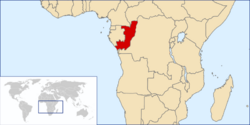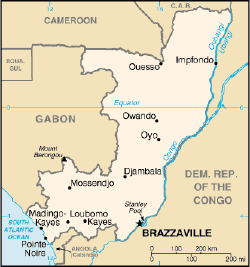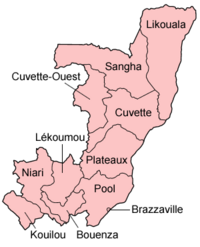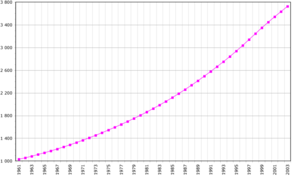Republic of the Congo
| République du Congo Republic of the Congo | |||||
| |||||
| Motto: "Unité, Travail, Progrès" (French) "Unity, Work, Progress" | |||||
| Anthem: La Congolaise | |||||
| Capital (and largest city) |
Brazzaville 4°14′S 15°14′E | ||||
| Official languages | French | ||||
|---|---|---|---|---|---|
| Government | Republic | ||||
| - President | Denis Sassou Nguesso | ||||
| - Prime Minister | Isidore Mvouba | ||||
| Independence | from France | ||||
| - Date | 15 August 1960 | ||||
| Area | |||||
| - Total | 342,000 km² (64th) 132,047 sq mi | ||||
| - Water (%) | 3.3 | ||||
| Population | |||||
| - 2005 estimate | 3,999,000 | ||||
| - {{{population_census_year}}} census | year = n/a | ||||
| - Density | 12/km² 31/sq mi | ||||
| GDP (PPP) | 2005 estimate | ||||
| - Total | $4.585 billion | ||||
| - Per capita | $1,369 | ||||
| HDI (2004) | |||||
| Currency | CFA franc (XAF)
| ||||
| Time zone | WAT (UTC{{{utc_offset}}}) | ||||
| Internet TLD | .cg | ||||
| Calling code | +242 | ||||
The Republic of the Congo, also known as Congo-Brazzaville, is a former French colony of western-central Africa. Upon independence in 1960, the former French region of Middle Congo became the Republic of the Congo. A quarter century of Marxism was abandoned in 1990 and a democratically elected government installed in 1992. A brief civil war in 1997 restored former Marxist President Denis Sassou Nguesso.
Geography
Congo is located in the central-western part of sub-Saharan Africa, Equator. To the south and east of it is the Democratic Republic of Congo. It is also bounded by Gabon to the west, Cameroon and the Central African Republic to the north, and Cabinda (Angola) to the southwest. It has a short Atlantic coast.
The capital, Brazzaville, is located on the Congo River, in the south of the country, immediately across from Kinshasa, the capital of the Democratic Republic of Congo.
The southwest of the country is a coastal plain for which the primary drainage is the Kouilou-Niari River; the interior of the country consists of a central plateau between two basins to the south and north.
Climate
The best overall time to visit is probably June-September. (The rainy season, October-May.) Since the country is located on the Equator, the climate is consistent year-round. The average daytime temperature is a humid 75 degrees F (24 degrees C), with nights generally in the 60s F (16-21 C).
History
The earliest inhabitants of the area were Pygmy peoples. They were largely replaced and absorbed by Bantu tribes during Bantu expansions. The Bakongo are comprised of Bantu groups that also occupied parts of present-day Angola, Gabon, and Democratic Republic of Congo, forming the basis for ethnic affinities and rivalries among those states. Several Bantu kingdoms—notably those of the Kongo, the Loango, and the Teke—built trade links leading into the Congo River basin.
The mouth of the Congo River was the base for the Kongo Kingdom which encountered the Portuguese in 1484. Trading contracts gave the Congolese textiles, jewelry, and manufactured goods in return for ivory, copper, and slaves. Western education and Christianity were introduced into the region at that time.
The Portuguese did not venture into the interior but bought goods and slaves through African brokers on the coast. When the slave trade diminished because of depopulation, the Portuguese bought slaves from other tribes. Fighting between the tribes weakened them as a group, including the Kongo. This increased the power of the Europeans and strengthened the slave trade. This situation continued until the European powers outlawed slavery in the late 1800s.
The Teke Kingdom of the interior signed a treaty with the French in 1883 that gave the French land in return for protection. Pierre Savorgnan de Brazza
The first European contacts came in the late fifteenth century, and commercial relationships were quickly established with the kingdoms to trade for slaves captured in the interior. The coastal area was a major source for the transatlantic slave trade, and when that commerce ended in the early nineteenth century, the power of the Bantu kingdoms eroded.
Independence
Following independence as the Congo Republic on August 15, 1960, Fulbert Youlou ruled as the country's first president until labor elements and rival political parties instigated a three-day uprising that ousted him. The Congolese military took charge of the country briefly and installed a civilian provisional government headed by Alphonse Massamba-Débat.
Under the 1963 constitution, Massamba-Débat was elected president for a five-year term but his term was ended abruptly with an August 1968 coup d'état. Capt. Marien Ngouabi, who had participated in the coup, assumed the presidency on December 31, 1968. One year later, President Ngouabi proclaimed Congo to be Africa's first "people's republic" and announced the decision of the National Revolutionary Movement to change its name to the Congolese Labor Party (PCT). On March 16, 1977, President Ngouabi was assassinated. An eleven-member Military Committee of the Party (CMP) was named to head an interim government with Col. (later Gen.) Joachim Yhombi-Opango to serve as president.
After decades of turbulent politics bolstered by Marxist-Leninist rhetoric, and with the collapse of the Soviet Union, Congo completed a transition to multiparty democracy with elections in August 1992. Denis Sassou Nguesso conceded defeat and Congo's new president, Prof. Pascal Lissouba, was inaugurated on August 31, 1992.
Civil unrest
Congo's democratic progress was derailed in 1997. As presidential elections scheduled for July 1997 approached, tensions between the Lissouba and Sassou camps mounted. On June 5, President Lissouba's government forces surrounded Sassou's compound in Brazzaville and Sassou ordered members of his private militia (known as "Cobras") to resist. Thus began a four-month conflict that destroyed or damaged much of Brazzaville and caused tens of thousands of civilian deaths. In early October, Angolan troops invaded Congo on the side of Sassou and, in mid-October, the Lissouba government fell. Soon thereafter, Sassou declared himself president. The Congo Civil War continued for another year and a half until a peace deal was struck between the various factions in December 1999.
2002 elections
Elections in 2002 saw Sassou win with almost 90 percent of the vote cast. His two main rivals, Lissouba and Bernard Kolelas, were prevented from competing and the only remaining credible rival, Andre Milongo, advised his supporters to boycott the elections and then withdrew from the race. A new constitution, agreed upon by referendum in January 2002, granted the president new powers and also extended his term to seven years as well as introduced a new bicameral assembly. International observers took issue with the organization of the presidential election as well as the constitutional referendum, both of which were reminiscent in their organization of Congo's era of single-party state.
2007 elections
With ballot counting under way after the first round of legislative elections, the widespread chaos and malpractices during voting could cast doubt on the final outcome, observers and residents said.
Polling stations opened late and voter registers and ballot papers were not available in many polling stations, observers from the African Union and Economic Community of Central African States said in a statement. The elections, on 24 June, were held to choose 137 deputies for the National Assembly. Congolese women have been thwarted in their ambition to improve their showing in the National Assembly after the first round in the Congolese legislative elections.
The results of the 24 June vote show that only one woman has been elected and it is unlikely the numbers will improve in the upcoming second round. The Centre for the Promotion of Women in Politics (CPFP) had worked hard to raise the profile of its women candidates in the legislative elections. Even though the status of women has improved, there are few women in top positions. In the two chambers in parliament, with 188 seats, there are only 20 women.
Chanel Loubaky Moundele from the human rights agency, Association des droits de l'homme et l'univers carcéral (ADHUC), and member of the Association des femmes juristes du Congo (AFJC), believes poverty is the biggest obstacle to women gaining better posts.
"Most Congolese are poor despite the resources of the country and there are more women and girls than men. They do not benefit from good access to communication, education, healthcare and good salaries and thus do not have the tools to start political careers," she said.
She believes Congo must adopt quota laws, as apply in Rwanda, to give significantly more women access to top positions that would enable them to improve their condition. "Thanks to the quotas," she said, "some countries have seen the number of women increase in their parliament; it is a form of positive discrimination favouring women implemented by many countries in the world. A representation of 30 percent would improve the situation of the women."
Congo, in line with many African countries, has more women than men, with more than 70 percent living below the poverty line.
Politics
The most important of the many parties are the Democratic and Patriotic Forces or FDP [Denis Sassou Nguesso, president], an alliance consisting of:
- Convention for Alternative Democracy
- Congolese Labor Party (PCT)
- Liberal Republican Party
- National Union for Democracy and Progress
- Patriotic Union for the National Reconstruction
- Union for the National Renewal
Other significant parties include:
- Congolese Movement for Democracy and Integral Development or MCDDI [Michel Mampouya]
- Pan-African Union for Social Development or UPADS [Martin Mberi]
- Rally for Democracy and Social Progress or RDPS [Jean-Pierre Thystere Tchicaya, president]
- Rally for Democracy and the Republic or RDR [Raymond Damasge Ngollo]
- Union for Democracy and Republic or UDR leader NA
- Union of Democratic Forces or UFD, Sebastian Ebao
Human rights
According to the U.S. State Department, the government's human rights record remains poor; although there were some improvements in 2006, serious problems remained. The following serious human rights problems were reported: mob violence, including killing of suspected criminals; security force beatings, physical abuse of detainees, rapes, looting, solicitation of bribes, and theft; harassment and extortion of civilians by uncontrolled and unidentified armed elements; poor prison conditions; impunity; arbitrary arrest; lengthy pretrial detention; a corrupt and ineffective judiciary; infringement on citizens' privacy rights; limits on freedom of the press; restrictions on freedom of movement; official corruption and lack of transparency; domestic violence and societal discrimination against women; trafficking in persons; discrimination on the basis of ethnicity, particularly against Pygmies; and child labor.
RESPECT FOR HUMAN RIGHTS
Administrative divisions
The Republic of the Congo is divided into ten regions and one commune, the capital Brazzaville. These are:
|
|
|
The regions are subdivided into forty-six districts.
Economy
The economy is a mixture of village agriculture and handicrafts, an industrial sector based largely on petroleum, support services, and a government characterized by budget problems and overstaffing. Petroleum extraction has supplanted forestry as the mainstay of the economy, providing a major share of government revenues and exports. In the early 1980s, rapidly rising oil revenues enabled the government to finance large-scale development projects with GDP growth averaging 5% annually, one of the highest rates in Africa. The government has mortgaged a substantial portion of its petroleum earnings, contributing to a shortage of revenues. The January 12, 1994 devaluation of Franc Zone currencies by 50% resulted in inflation of 61% in 1994, but inflation has subsided since. Economic reform efforts continued with the support of international organizations, notably the World Bank and the IMF. The reform program came to a halt in June 1997 when civil war erupted. When Sassou Nguesso returned to power at the war ended in October 1997, he publicly expressed interest in moving forward on economic reforms and privatization and in renewing cooperation with international financial institutions. However, economic progress was badly hurt by slumping oil prices and the resumption of armed conflict in December 1998, which worsened the republic's budget deficit. The current administration presides over an uneasy internal peace and faces difficult economic problems of stimulating recovery and reducing poverty, despite record-high oil prices since 2003. Natural gas and diamonds are also recent major Congolese exports, although Congo was excluded from the Kimberley Process in 2004 amid allegations that most of its diamond exports were in fact being smuggled out of the neighboring Democratic Republic of Congo.
Basic Economy. Agriculture, industry, and services dominate the economy. The most important products are lumber, plywood, sugar, cocoa, coffee, diamonds, and especially oil.
Land Tenure and Property. Under communist rule, the government was the owner of all commercial property. After the civil war, privatization was decreed. Almost 90 percent of homes are now owned by individuals or families.
Commercial Activities. Minor agricultural products and light manufactured goods are sold in informal street markets.
Major Industries. The major industry is petroleum extraction. Cement kilning, forestry, brewing, sugar milling, palm oil, soap, and cigarette making also are important industries.
Trade. The largest export partner is the United States, followed by Belgium and Luxembourg, Taiwan, and China. Oil accounted for 50 percent of the gross national product in 1997. Imported items include manufactured goods, capital equipment, petroleum products, construction materials, and food. These items are imported from France, Italy, the United States and the United Kingdom. The country is deeply in debt.
Demographics
The Republic of the Congo's sparse population is concentrated in the southwestern portion of the country, leaving the vast areas of tropical jungle in the north virtually uninhabited. Thus, Congo is one of the most urbanized countries in Africa, with 85 percent of its total population living in a few urban areas, namely in Brazzaville, Pointe-Noire, or one of the small cities or villages lining the 332-mile railway that connects the two cities. In rural areas, industrial and commercial activity has declined rapidly in recent years, leaving rural economies dependent on the government for support and subsistence. Before the 1997 war, about 15,000 Europeans and other non-Africans lived in Congo, most of whom were French. Presently, only about 9,500 remain.
There are fifteen main ethnic groups and seventy-five subgroups. The largest ethnic groups are the Bakongo (48 percent of the population), the Sangha (20 percent), the Teke (17 percent), and the M'Bochi (12 percent). The Teke group suffers from widespread discrimination from all the other ethnic groups in Central Africa because they are unorganized forest dwellers with little political power.
Religion
There is no official state religion; the Fundamental Act mandates freedom of religion. About 50 percent of the people are Christian. Forty-eight percent of the people adhere to native religions and the remaining 2 percent are Muslim. Varying combinations of Christianity and animism have developed. In some rural areas, Christian missionaries have had little success in converting the forest dwellers.
Before the coming of Christianity, all the native religions were animist. The monotheistic religion of Nzambi is widely practiced among the Bakongo. In this tradition, Nzambi created the world after a great sickness, vomiting first the sun, then the stars, animals, and people. After the creation, he went to live with the ancestral spirits. It is believed that family members join the ancestral world after death to protect the living. In cases of wrongful or violent death, they roam until retribution has occurred. Medicine and religion are often indistinguishable in the native religions.
Culture
French is the official language and is used in governmental activities. Lingala and Monokutuba are commonly spoken trade languages. Over sixty local languages and dialects are spoken, the most widely used of which are Kikongo, Sangha, and Bateke. A talking drum language developed in the villages as a form of long-distance communication. Specific beats are broadcast for marriages, deaths, births, and other information.
Under communism, urban and educated people had jobs and could make more money than rural people, who had a lifestyle closer to that of the ethnic tribes. Discrimination against the pygmies, known as Teke, Aka, or forest dwellers, is widespread. They are turned away from hospitals, receive lower pay, and are not represented in the government. The literacy rate for the total population is 83.8 percent (male 89.6% and female: 78.4% (2003 est.)).
Symbols of Social Stratification. Because of communism and local social customs, few people have accumulated personal wealth.
Women are underrepresented in politics and the higher levels of the government. In rural areas, women are often discouraged from attaining paid employment and education at the high school level. They are instead encouraged to focus on family and child-rearing activities. This gives them limited power in social dealings with men, who typically are better educated and have more money. Nongovernmental organizations such as the Ministry of Public Service and the Promotion of Women have started government initiatives to improve the status of women. MARRIAGE,FAMILY, AND KINSHIP
Marriage. Traditionally, family members arranged marriages. Today, this is less common, especially in the cities. A practice that dates back to ancient times is the dot, or brideprice. Once price has been set between the two families, the groom must pay it to the wife's family. The dot is often very high.
After the marriage, a ritual is performed to demonstrate the virginity of the bride. The morning after the wedding night, women from both sides of the family go to the couple's bed. Questions are asked about the wedding night, and the presence of blood provides evidence of virginity. If virginity is not proved, the marriage can be annulled and the groom can ask for the return of the brideprice.
After a divorce the man can ask for his brideprice back. Because most women can not repay it, divorce is mostly a male option. Polygyny is allowed, but polyandry is illegal. Adultery is illegal only for women.
Domestic Unit. The concept of the nuclear family does not apply in much of the country. The family includes many relatives, such as grandparents, uncles, aunts, cousins, nephews, and nieces. The average woman bears five children, although in rural areas the number is often twice that high.
Inheritance. The Legal Code states that 30 percent of a husband's estate must go to his widow. Very often this code is not adhered to, and a surviving wife may not get any of her husband's assets.
Kin Groups. Many of the ethnic groups, including the Bakongo, are matrilineal. The oldest uncle on A group of women holding papal flags and wooden crosses on the streets of Congo. A group of women holding papal flags and wooden crosses on the streets of Congo. the mother's side is considered the most important male and sometimes has more influence over a child's life than does the father. This uncle can be responsible for the child's education, employment, and marriage selection. Cousins on the mother's side are considered siblings. The family is responsible for sick, handicapped, and elderly members. Any care that is needed is distributed throughout the entire family system.
SOCIALIZATION
Infant Care. The infant mortality rate is high, and for this reason women tend to bear many children. Care of infants is largely a female responsibility, though forest dwellers tend to share parental duties.
The major holidays are Christmas, New Year's, Easter, All Saints Day, National Reconciliation Day ( June 10), Tree Day (March 6), and Independence Day (August 15).
Storytelling is part of the cultural tradition. Since the introduction of written language, novels, plays, and poems have become more popular. The Congolese are known for their singing. Songs fill the air during the performance of chores. Rumba and other forms of music are played with native and Western instruments.
ReferencesISBN links support NWE through referral fees
- Culture of Republic of Congo. [1]
- Cutter, Charles Hickman. 2006. Africa, 2006. World Today series. Harpers Ferry, WV: Stryker-Post Publications. ISBN 1887985727 and ISBN 9781887985727
- July, Robert W. 1992. A History of the African People, 4th ed. Prospect Heights, IL: Waveland Press. ISBN 0881336319
External links
- News
- AllAfrica.com - Congo-Brazzaville news headline links
- IRIN News for Congo, from the United Nations
- Overviews
- Culture
- Directories
- Open Directory Project - Republic of the Congo directory category
- Stanford University - Africa South of the Sahara: Congo-Brazzaville directory category
- The Index on Africa - Congo-Brazzaville directory category
- University of Pennsylvania - African Studies Center: Congo directory category
- Yahoo! - Congo (Brazzaville) directory category
- Ethnic groups
- Baka Pygmies of Cameroon and Congo Culture and music of the first inhabitants of Congo
- Human Rights
- [2] Amnesty International Human Rights Report, 2006
Credits
New World Encyclopedia writers and editors rewrote and completed the Wikipedia article in accordance with New World Encyclopedia standards. This article abides by terms of the Creative Commons CC-by-sa 3.0 License (CC-by-sa), which may be used and disseminated with proper attribution. Credit is due under the terms of this license that can reference both the New World Encyclopedia contributors and the selfless volunteer contributors of the Wikimedia Foundation. To cite this article click here for a list of acceptable citing formats.The history of earlier contributions by wikipedians is accessible to researchers here:
The history of this article since it was imported to New World Encyclopedia:
Note: Some restrictions may apply to use of individual images which are separately licensed.




